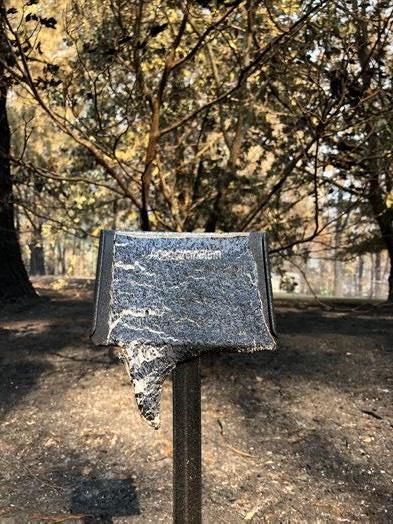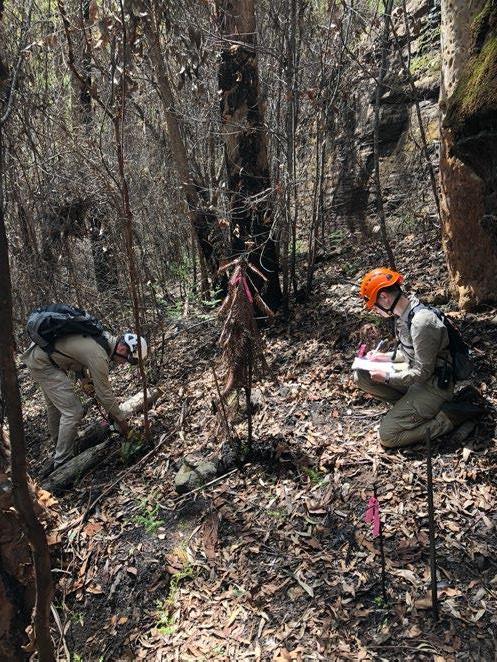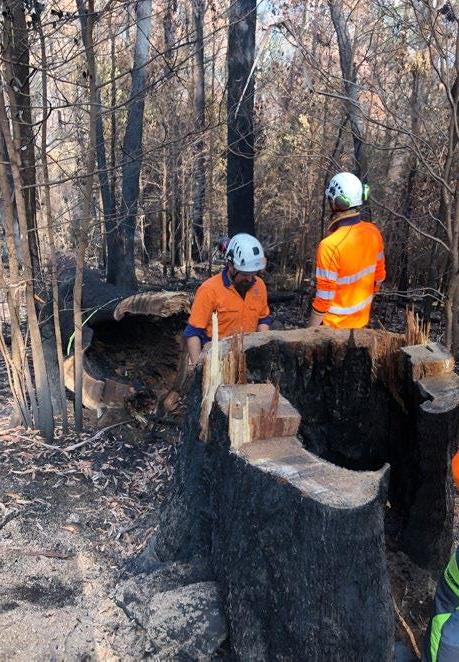
10 minute read
Mount Tomah and the Order of the Phoenix: the garden rises from the ashes
Ian Allan, Supervisor of Arboriculture and Natural Areas, Blue Mountains Botanic Garden Mount Tomah
You’d be forgiven for forgetting about all that came before ‘the rona’. The omnipresent crisis and the 24-hour news cycle have made the bushfires that ravaged Australia’s east coast last summer seem like a distant memory for many, yet for the team at the Blue Mountains Botanic Garden Mount Tomah, the reminders are ubiquitous and there is still a lot of work to be done.
You’d also be forgiven for thinking; ‘not another bushfire story!’, but never fear, we too were suffering from bushfire media burnout (pun intended), so here’s a story on the positive side of things and on what makes our road to recovery different from that of an average garden.
The basalt rocks had no sooner cooled amongst the ash, nor had all the fires been extinguished, before we were busy planning the recovery effort. Trees needed to be assessed and areas made safe, essential infrastructure needed repair or replacement, staff needed support and stories needed to be told. All those things are common to anyone whose property has been burnt, and much has been written about that side of things; however, what is less obvious is what we needed to do as highly qualified horticulturists, arborists and scientists. And what was different about the response required by a botanic garden.
It would have been easy to rush straight in and start ‘cleaning-up’ all the burnt areas. The desire to remove the visible reminders of the fire and to focus on aesthetics may have helped us all move on, yet botanic gardens are first and foremost a horticultural and scientific institution. We manage and care for a living collection of rare plants from around the world, as well as 240 hectares of our World Heritage Wilderness area. We keep records on every one of the plants in the collection, not just for posterity’s sake, but for scientific research and to improve the global knowledge base for each species in our care. Our conservation area doesn’t exist just to lock-up a parcel of land like a national park; it is an essential piece of high-quality wilderness that can be studied, and where we can carefully refine our management techniques.
With 90% of the wilderness area burnt and hundreds of living collection specimens directly impacted by the fire, there was essential research to be done so we could better understand exactly what had happened and how the plants would respond. To miss the opportunity to assess the plants, collect data and establish baseline information for monitoring plant and ecosystem recovery would have been folly. It would also have robbed us of a sense that there are silver linings to such a catastrophe.
Thankfully, we had immense support from our directors, who allowed us to lead the direction of this work. Some of you may also recall Greg Bourke, our Curator Manager, speaking about the value of plants at the last BGANZ congress. Well, the background to that talk was that we had already been discussing the value of our living collections, not just to science and conservation, but also its dollar value. To have potentially lost hundreds of plants, many of which had been wild-sourced, imported via complex and costly quarantine processes, and which may be incredibly rare, meant that we quickly engaged with our insurers to discuss the possibility of recouping some of that value. This of course meant that we needed to develop a quick and effective method of assessing the plants to confirm which were in fact lost to the fire. The method also needed to be transparent and able to withstand scrutiny. This went hand-in-hand with a scientific assessment, so we simply incorporated the insurance assessment into the process.
To have potentially lost hundreds of plants meant that we quickly engaged with our insurers to discuss the possibility of recouping some of that value.
The assessments of the living collection and the natural bush were very separate tasks. For instance, we needed to assess individual items in the living collection, whereas the scale of the natural areas meant that we would be assessing plant communities, not individuals. One method of assessment would not fit both, so we planned to first assess the conservation areas, then refine our methods for assessing the collection.
View of the lower garden after the fire. Photo: Blue Mountains Botanic Garden Mount Tomah.
There was lots of research and expertise out there on assessing bushfire impacts on the bush, but less for assessing bushfire impacts on botanical collections of exotic and rare species.
First, we needed to determine the varying intensities of the fire that had moved through the different areas so we could then assess the impacts those fire types had on individual species and the array of ecological plant communities found across the estate. Whether the fire had been an intensely hot ‘canopy’ fire, or a cooler ‘trickle’ burn is one of the most significant factors influencing both the response of individual species, and ecological recovery. Contrary to the reductive reporting in the media of ‘fire-storms’ and wholesale ecological disaster, the few of us who had been on-site during the fire event and its aftermath had observed a far more complex situation and some ground-truthing of what had occurred was required. This was even more apparent when we found that the Light Detecting and Remote Sensing technology (LiDAR) mapping of the fire-affected areas done by the New South Wales government spatial information service indicated that much of the rainforest we manage was unburnt even though our first forays into those areas told a different story. This baseline information would also be essential if we were to monitor short- and long-term plant responses.

The wilderness area. Photo: Blue Mountains Botanic Garden Mount Tomah.

Luckily for us, we have a wide network of experts to call upon, and our involvement in the Wollemi Pine Wollemia nobilis Recovery Plan meant that we were straight into discussions with the team of scientists tasked with assessing the wild populations of the
A melted tree label. Photo: Blue Mountains Botanic Garden Mount Tomah.
ancient trees. Our own scientists also had a pre-established monitoring plot in our conservation area, so we roped them in too! After several meetings to determine the best method of assessment and set up our systems, our Natural Areas team set to task.
One of the first tasks was assisting Dr Heidi Zimmer, Senior Scientist (Ecosystems and Threatened Species) with the Department of Planning Industry and Environment, to assess the Wollemi Pine translocation site that we manage. Heidi did her PhD on the translocation site and assisting her with the post-fire assessment was vital in our planning of the living collection assessment and our learnings informed the method of assessment used for the wild trees. Sadly, the entire translocation population was burnt, and while the results are yet to be published, we were thrilled to find that some of them had re-sprouted and appear to be recovering well.
We had already learned from our research and meetings that an essential element of bushfire assessment was speed. The ephemeral nature of a few key indicators of fire intensity, namely scorch and char height, and canopy foliage remaining, meant that we needed to be quick. After a quick review and research phase, we confirmed our method and dove on in.
We broke the natural area down into zones based on known pre-fire ecological communities and obvious differences in fire intensity (canopy fire versus ground fire) and topography. In these zones we then established assessment and monitoring plots, photo-monitoring points and soil sample locations. This ended up consisting of 10 x 50 m transects with 5 x 1 m2 monitoring plots on each. For each of these transects we then recorded observations on average scorch and char heights relative to the height of the dominant stratum, canopy damage, shrub-layer damage and the soil O-horizon condition. Each of these elements interpreted in isolation may not give a true indication of fire intensity, yet when understood collectively, they paint an accurate picture of the fire intensity and its impacts.
We are still finalising our report on this initial impact assessment and won’t truly understand the ecological impacts until we have analysed at least 12 months of monitoring data on the species regenerating in the 50 monitoring plots. In general, however, it appears that there are some ecological communities that will never be the same again, while a couple of others were burnt at just the right intensity to see a possible increase in plant biodiversity and hopefully a strong recovery.
While the Natural Areas team continued with that immense task, the team inside the cultivated garden re-jigged the methods slightly, added the insurance element and set out to assess hundreds of fire-affected accessions.

View of the garden after the fire. Photo: Blue Mountains Botanic Garden Mount Tomah.
We were all still relatively new to the nuances of IrisBG, the software used for managing our collection records. The limited experience we had, however, suggested it would be possible to utilise its report and mapping functions to set up an assessment method we could perform using a combination of the Floria app and Microsoft Excel on tablets in the field. This was all the more important given that many of the tags and labels on the fire-affected plants had melted, leaving only our ID skills (not much good on charred, leafless plants!) and GPS coordinates to confirm which plant was which.
Again, drawing from our consultation with experts and the method used for the Wollemi Pines, we devised a quick impact assessment method with a few extra observations to help build the global knowledge base of each affected species’ response to fire. These included whether there was recruitment from seed, if there was basal or stem re-sprouting, scorch and char height relative to the plant height, and if the plant was alive or dead. We also reserved the determination of alive/dead for many of the deciduous tree species until new spring growth could be observed.
Natural Areas horticulturist Stuart Allan, and horticultural apprentice Laura King assessing Wollemi Pines. Photo: Blue Mountains Botanic Garden Mount Tomah. Arborists Chris Crottey and Matt Coyne admire the felling skill of senior arborist Antony Rivers. Photo: Blue Mountains Botanic Garden Mount Tomah.


To assist in compiling accurate costs for recovery works we also recorded the melted tags and labels, and the work required, such as pruning or removals.

With a second round of assessment due in late spring 2020 we are yet to finalise the numbers of plants lost, but to date, 567 individual living collection items have been assessed as being directly impacted by fire (burnt
View of the lower garden after the fire. Photo: Blue Mountains Botanic Garden Mount Tomah.
or scorched), with 235 assessed for removal and 147 additional removals to be confirmed. Over a third of these items are trees predominately in our North American Woodland and Conifer Cultivar collection.
Inside the fences surrounding the cultivated garden, a large section of the naturally occurring Blue Mountains Basalt-cap Forest threatened ecological community bore the brunt of the fire. Within this community almost 500 trees with a diameter at breast height (DBH) of more than 150 mm were assessed as fire-affected and were added to our database.
While negotiations with the insurers continue, the assessment and database records have been provided to an independent expert who is developing a valuation methodology and valuing the lost items. Contractors are being engaged to clear assessed trees and we are commencing the long road to re-designing burnt areas, sourcing replacement plant material and ensuring that the story of what happened is interpreted throughout the garden.
There’s still a lot to do: we continue to assess tree risk, manage the significant weed incursions into the wilderness areas and gradually re-open areas to the public, but it’s starting to feel like there’s a light at the end of the tunnel. The way we have handled our response, the things we’ve learned and the little unexpected discoveries, such as the abundance of native terrestrial orchids we are finding, make the task all the easier to bear.










